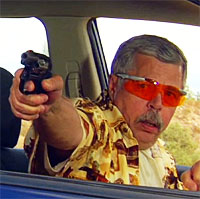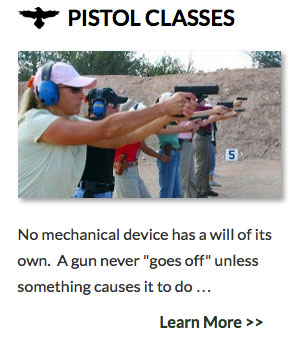Widgetized Section
Go to Admin » Appearance » Widgets » and move Gabfire Widget: Social into that MastheadOverlay zone
Practical Rifle Zero
 Although there are many uses for rifles and many forms of rifle competition, as a practical rifleman our concerns are chiefly hunting and defensive uses of the rifle at reasonable ranges. Reasonable ranges may be defined as the distances at which we can expect to be taking game or defending ourselves and can quickly and reliably get first round hits under field conditions. Let me say that again: quickly and reliably get first round hits under field conditions. For most of us, this distance is going to be from right off the end of the muzzle out to 300 or 400 yards. Practical rifles are those rifles suited to hunting or defensive use that are sufficiently lightweight and user friendly to be carried all day.
Although there are many uses for rifles and many forms of rifle competition, as a practical rifleman our concerns are chiefly hunting and defensive uses of the rifle at reasonable ranges. Reasonable ranges may be defined as the distances at which we can expect to be taking game or defending ourselves and can quickly and reliably get first round hits under field conditions. Let me say that again: quickly and reliably get first round hits under field conditions. For most of us, this distance is going to be from right off the end of the muzzle out to 300 or 400 yards. Practical rifles are those rifles suited to hunting or defensive use that are sufficiently lightweight and user friendly to be carried all day.
Getting Zeroed
Zeroing a rifle means adjusting the sights so the point of aim and the point of impact intersect at some predetermined range, referred to as the zero range. Whether using iron or optical sights we can imagine the line of sight as being a straight line and the bullet path as defining an arc. We adjust the sights so the barrel is actually pointing up in relation to the line of sight. Once leaving the barrel, the bullet will cross the line of sight at the initial intersection then cross the line of sight again as gravity draws it back to the line of sight, referred to as the zero range, usually something like 100, 200, or 250 yards.
To determine a practical rifle zero range we need to define the target size. For defensive or hunting purposes this will be the vital zone of a man or game animal, about an eight-inch circle or sphere. Next, we can adjust the zero range so that the path of the bullet will remain within our vital zone; that is, holding center, the bullet path will not be more than four inches above or below the line of sight. Here are a couple of examples with a .308 Ruger Gunsite Scout shooting Hornady Superformance 165 grain ammunition with a muzzle velocity of 2646 feet per second (fps) and a .223 Ruger SR556E shooting Hornady 75 grain ammunition with a muzzle velocity of 2534 fps, both rifles with 16.5″ barrels:
| .308 | .223 | |
| Muzzle | -1.5″ | -2.5″ |
| 50 yards | +1.0″ | +0.5″ |
| 100 yards | +2.1″ | +2.0″ |
| 200 yards | 0.0″ | 0.0″ |
| 300 yards | -9.0″ | -9.8″ |
| 400 yards | -25.9″ | -29.1″ |
At the muzzle the bullet is going to start below the line of sight. At about 25 yards the bullet crosses the line of sight the first time and again at 200 yards. This means we can hold center all the way out to about 235 yards without having to make sight adjustments or adjust point of aim and our hits will stay inside that 8 inch vital zone. Note also how similar the trajectories are for both the .308 and the .223. For all practical purposes, in the field they are the same.
Everyone would agree that a one-minute rifle is very accurate. This means the rifle is capable of shooting into one minute of angle (MOA); let’s call it one inch at 100 yards. If the rifle can do that, and we can shoot up to our rifle, our smallest potential group size at 200 yards is 2 inches, at 300 yards 3 inches and at 400 yards 4 inches. What if we can only manage 2, 3 or 4 MOA accuracy in the field?
| 2 MOA group | 3 MOA group | 4 MOA group | |
| 100 yards: | 2 inches | 3 inches | 4 inches |
| 200 yards: | 4 inches | 6 inches | 8 inches |
| 300 yards: | 6 inches | 9 inches | 12 inches |
| 400 yards: | 8 inches | 12 inches | 16 inches |
As you can see from the chart, keeping shots in the 8-inch vital zone isn’t easy, especially if we increase the range beyond 300 or 400 yards.
Making It Easy
Here’s an easy way to get set up practical accuracy. Let’s say we’re sighting in a .308 or .223 rifle for a 200 yard zero. I like to start by zeroing at 25 yards from a steady shooting position to make sure I’m on the paper. Once I’m centered at 25 yards I move to 200 yards and fine tune the zero. Only then do I shoot 100 yards, where I should be about 2 inches high then finish up at 300 yards.
Having established a 200 yard zero here’s the way it might work at various practical ranges:
| 10 yards | Hold center. The bullet will impact about 2 inches low depending upon scope height. If you need a very precise shot hold high to eliminate the offset. |
| 25 yards | Hold center. |
| 50 yards | Hold center. Your bullet may impact an inch or so high. Forget it. |
| 100 yards | Hold center. Your bullet may impact a couple of inches high. Forget it. |
| 200 yards | Hold center. |
| 250 yards | Hold high center at the top of the vital zone. |
| 300 yards | Place the horizontal crosswire on the shoulders, the bullet will impact about 9 inches down in the vital zone. |
| 400 yards | Place the horizontal crosswire above the head, the bullet will impact about 25 inches down in the vital zone. |
Using these holds allows you to quickly get hits without having to worry about ranging, dialing in the range, doing math in your head or doing other things that take time. See it, get steady, and quickly make your shot. It doesn’t have to be a perfect hit; it just has to be good enough. Obviously, various calibers, bullets and velocities will not perform the same as these examples. Depending upon the size of the vital zone you expect to deal with and the velocity and caliber of your rifle you may wish to use a different zero range. The idea is to figure out a zero range based on the size of your intended target that allows you to hold center and make quick hits at practical ranges under field conditions. Give this a try; get off the bench rest, don’t worry about shooting groups, and see how quickly you can make that one good hit.
About the Author:
 Ed Head is a regular on Shooting Gallery, Gun Stories and Down Range TV. He has worked for almost 30 years in law enforcement, first in the United States Air Force and then with the United States Border Patrol, retiring as a Field Operations Supervisor. During his Border Patrol career, Ed worked in a variety of patrol, investigative and training capacities. Ed has an extensive background as a firearms instructor, having trained thousands, ranging from beginners to police, military and special operations personnel. Having taught at Gunsite for 20 years, Ed first trained there under the world famous shooting school’s founder, Jeff Cooper, then later ran the school as the operations manager for more than five years. Ed lives in Chino Valley, Arizona, where he continues to teach and write.
Ed Head is a regular on Shooting Gallery, Gun Stories and Down Range TV. He has worked for almost 30 years in law enforcement, first in the United States Air Force and then with the United States Border Patrol, retiring as a Field Operations Supervisor. During his Border Patrol career, Ed worked in a variety of patrol, investigative and training capacities. Ed has an extensive background as a firearms instructor, having trained thousands, ranging from beginners to police, military and special operations personnel. Having taught at Gunsite for 20 years, Ed first trained there under the world famous shooting school’s founder, Jeff Cooper, then later ran the school as the operations manager for more than five years. Ed lives in Chino Valley, Arizona, where he continues to teach and write.



 MidwayUSA
MidwayUSA Ruger Firearms
Ruger Firearms SCCY Firearms
SCCY Firearms Streamlight
Streamlight Action Targets
Action Targets Gunsite Academy
Gunsite Academy
You must be logged in to post a comment Login